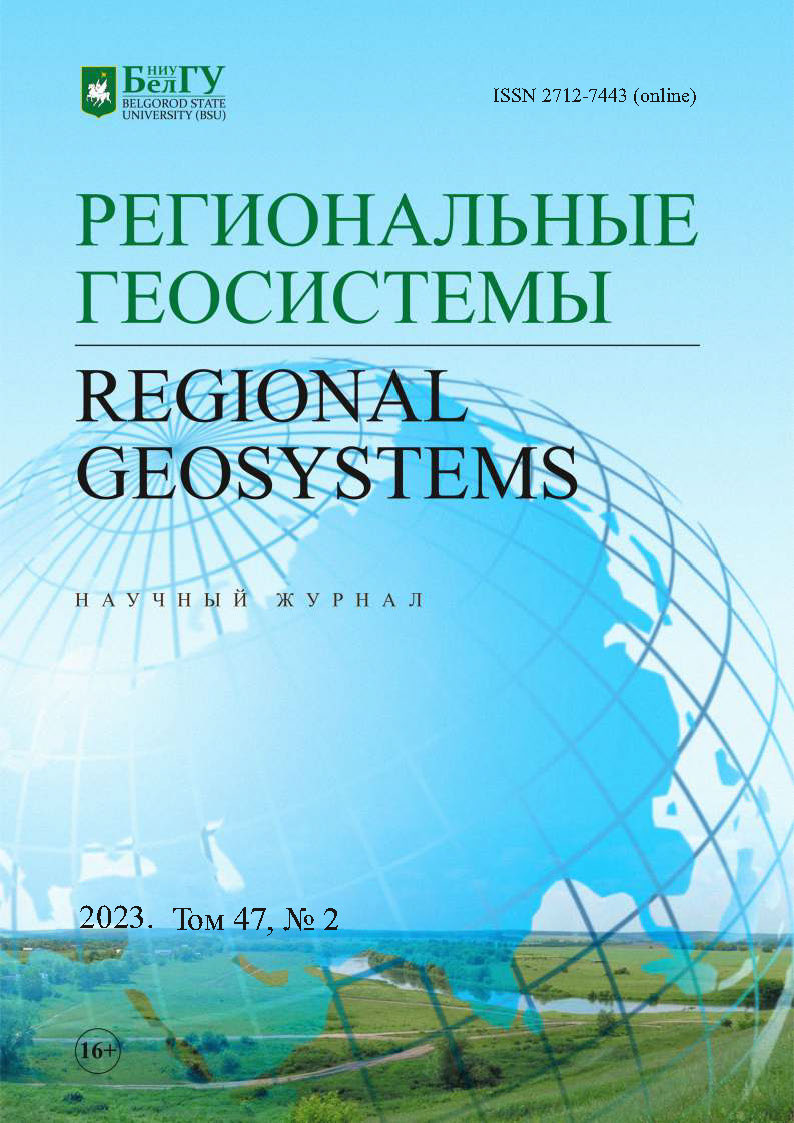Comprehensive Assessment of Flood Risks in the Jewish Autonomous Region
DOI:
https://doi.org/10.52575/2712-7443-2023-47-2-296-305Keywords:
flood, risk, vulnerability, vulnerability index, exposure index, Jewish Autonomous RegionAbstract
The territories of the Amur River basin are among the most prone to flooding in the south of the Russian Far East, including the Jewish Autonomous Region (JAR). For more than 120 years of observations, catastrophic floods in this area were recorded in 17 % of the years, including in the years 2013 and 2019. A comprehensive flood risk assessment consists of two components: exposure or natural hazard (physical factors) and vulnerability (socio-economic factors). The integrated risk assessment method was developed and used by the UN to assess the risk index for different countries. The same method was used at the local levels for the regions of Russia and municipalities of the Krasnodar Krai. The purpose of this study is a comprehensive assessment of flood risks for the districts and the city of Birobidzhan of the Jewish Autonomous Region. The index of vulnerability of the population of the JAR to floods was calculated earlier. In this study, based on data on the flooding of the territories of the region, the index of the population's exposure to floods was calculated. Further, on the basis of the obtained indices, an integral flood risk index was calculated for each district of the region and the city of Birobidzhan. The data obtained make it possible to assess the situation in individual administrative-territorial units and, based on them, make decisions on the priority of assistance in emergency situations and the allocation of funding for the elimination of consequences.
Downloads
References
Аношкин А.В. 2014. Обзор гидрологического режима территории среднего течения реки Амур в период катастрофического наводнения 2013 года. Известия Самарского научного центра Российской академии наук, 16(1–4): 938–941.
Аношкин А.В., Зубарев В.А., Потурай В.А. 2018. Глава 5. Внутренние воды. В кн.: География Еврейской автономной области: общий обзор. Под ред. Фрисмана Е.Я. Биробиджан, ИКАРП ДВО РАН: 51–80.
Бортин Н.Н. 2017. Проблемы комплексного использования и управления водными ресурсами на территории Амурского бассейна. Водное хозяйство России: проблемы, технологии, управление, 6: 16–33.
Гладкевич Г.И., Терский П.Н., Фролова Н.Л. 2012. Оценка опасности наводнений на территории Российской Федерации. Водное хозяйство России: проблемы, технологии, управление, 2: 29–46.
Григорьева Е.А., Ревич Б.А. 2021. Риски здоровью российского населения от погодных экстремумов в 2010–2020 гг. Часть 2. Наводнения, тайфуны, ледяной дождь, засухи. Проблемы анализа риска, 18(3): 10–31. DOI: 10.32686/1812-5220-2021-18-3-10-31
Добровольский С.Г., Истомина М.Н., Пасечкина В.Ю. 2018. Изменения естественных параметров экстремальных гидрологических явлений в России и в мире и вызванных ими ущербов: наводнения и засухи. Вопросы Географии, 145: 183–193.
Земцов С.П., Крыленко И.Н., Юмина Н.М. 2012. Социально-экономическая оценка риска наводнений в прибрежных зонах азово-черноморского побережья Краснодарского края. В кн.: Природные и социальные риски в береговой зоне Черного и Азовского морей. Сборник научных статей по итогам семинара, Москва, 16–19 июня 2012. Москва, Издательство ТРИУМФ: 86–96.
Костин И.С., Покровская Т.В. 1953. Климатология. Л., Гидрометеоиздат, 427 c.
Ливенец А.С. 2022. Индекс уязвимости населения Еврейской автономной области к наводнениям. Региональные проблемы, 25(4): 31–40. DOI: 10.31433/2618-9593-2022-25-4-31-40
Махинов А.Н., Ким В.И. 2020. Влияние изменений климата на гидрологический режим реки Амур. Тихоокеанская география, 1(1): 30–39. DOI: 10.35735/7102875.2020.1.1.004
Разумов В.В., Качанов С.А., Разумова Н.В., Чириков А.Г., Шагин С.И., Беккиев М.Ю., Глушко А.Я., Пчелкин В.И., Фролко С.В. 2018. Масштабы и опасность наводнений в регионах России. Москва, ВНИИ по проблемам ГО и ЧС МЧС России, 364 с.
Bigi V., Comino E., Fontana M., Pezzoli A., Rosso M. 2021. Flood Vulnerability Analysis in Urban Context: A Socioeconomic Sub-Indicators Overview. Climate, 9(1): 12. DOI: 10.3390/cli9010012
Chan S.W., Abid Sh.K., Sulaiman N., Nazir U., Azam K. 2022 A Systematic Review of the Flood Vulnerability Using Geographic Information System. Heliyon, 3(8): e09075. DOI: 10.1016/j.heliyon.2022.e09075
Damm M. 2010. Mapping Social-Ecological Vulnerability to Flooding – A sub-national approach for Germany. Inaugural – Dissertation. München, 226 p.
Fekete A. 2010. Assessment of Social Vulnerability to River Floods in Germany. Publication Series of UNU-EHS, 4: 119.
Grigorieva E.A., Livenets A.S. 2022. Risks to the Health of Russian Population from Floods and Droughts in 2010–2020: A Scoping Review. Climate, 10(3): 37. DOI: 10.3390/cli10030037
Kirby R.H., Reams M.A., Lam N.S.N., Zou L., Dekker G.G.J., Fundter D.Q.P. 2019. Assessing Social Vulnerability to Flood Hazards in the Dutch Province of Zeeland. International Journal of Disaster Risk Science, 10(2): 233–243. DOI: 10.1007/s13753-019-0222-0
Liu W.-C., Hsieh T.-H., Liu H.-M. 2021. Flood Risk Assessment in Urban Areas of Southern Taiwan. Sustainability, 13(6): 3180. DOI: 10.3390/su13063180
Nasiri H., Mohd Yusof M.J., Mohammad Ali T.A. 2016. An Overview to Flood Vulnerability Assessment Methods. Sustainable Water Resources Management, 2(3): 331–336. DOI: 10.1007/s40899-016-0051-x
Rehman S., Sahana M., Hong H., Sajjad H., Ahmed B.B. 2019. A Systematic Review on Approaches and Methods Used for Flood Vulnerability Assessment: Framework for Future Research. Natural Hazards, 96(2): 975–998. DOI: 10.1007/s11069-018-03567-z
Zemtsov S., Baburin V., Koltermann K., Krylenko I., Yumina N., Litvinov V. 2014. Social Risk and Vulnerability Assessment of the Hazardous Hydrological Phenomena in the Krasnodar Region of Russia. Geography, Environment, Sustainability, 4(7): 95–117.
Abstract views: 154
Share
Published
How to Cite
Issue
Section
Copyright (c) 2023 Regional Geosystems

This work is licensed under a Creative Commons Attribution 4.0 International License.


